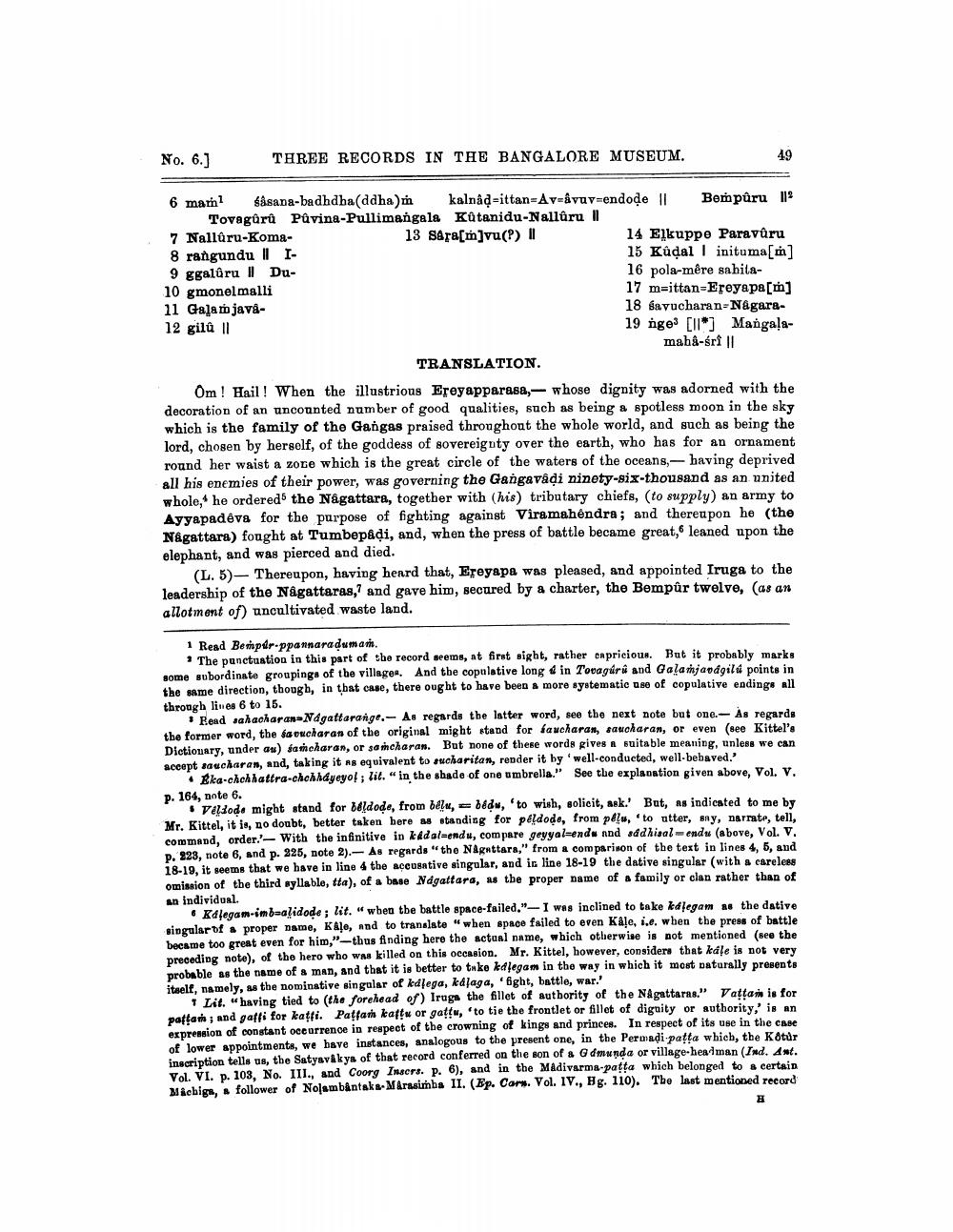________________
No. 6.)
THREE RECORDS IN THE BANGALORE MUSEUM
6 man fåsana-badhdbaddha) kalnad-ittan-Av=&vuv-endode || Bempûru |
Tovagurů Půvina-Pullimangala Kütanidu-Nallûrul 7 Nallûru-Koma
13 Sara[m]vu(P) |
14 Elkuppe Paravûru 8 rangundu | I
15 Kudal inituma[m] 9 ggalûru | Du
16 pola-mêre sahita10 gmonelmalli
17 m=ittan-Ereyapa[m] 11 Galam java
18 savucharan-N&gara12 gilû 11
19 nges [IIMangala
maba-bri || TRANSLATION. Om ! Hail! When the illustrious Ereyapparasa, whose dignity was adorned with the decoration of an uncounted number of good qualities, such as being a spotless moon in the sky which is the family of the Gangas praised throughout the whole world, and such as being the lord, chosen by herself, of the goddess of sovereignty over the earth, who has for an ornament round her waist a zoce which is the great circle of the waters of the oceans, - having deprived all his enemies of their power, was governing the Gangavadi ninety-six-thousand as an united whole," he ordered the Någattara, together with (his) tributary chiefs, (to supply) an army to Ayyapadeva for the purpose of fighting against Viramahendra; and thereupon he (the Negattara) fought at Tumbepadi, and, when the press of battle became great, leaned upon the elephant, and was pierced and died.
(L. 5)- Thereupon, having heard that, Eregapa was pleased, and appointed Iruga to the leadership of the Nâgattaras, and gave him, secured by a charter, the Bempûr twelve, as an allotment of) uncultivated waste land.
1 Read Bemper.ppannaraduman.
- The punctuation in this part of the record seems, at first sight, rather capricious. But it probably marks some subordinate groupinga of the villager. And the copulative long din Tovagiri and Galanjangils points in the same direction, though, in that case, there ought to have been a more systematic use of copulative endings all through lines 6 to 15.
* Read Jahaoharan-Ndgaftarange. -As regards the latter word, see the next note but one-As regards the former word, the facucharan of the original might stand for faucharan, sanoharan, or even (see Kittel's Dictionary, under au) samcharan, or soicharan. But none of these words gives a suitable meaning, unless we can accept saccharan, and, taking it as equivalent to sucharitas, render it by 'well-conducted, well-bebaved.'
• Eka-chchhattra-chehhdyeyol, lil." in the shade of one umbrella." See the explanation given above, Vol. V. p. 164, note 6.
valdodo might stand for 86]dode, from be, bedw, to wish, solicit, ask.! But, as indicated to me by Mr. Kittel, it is, no doubt, better taken bere as standitg for peļdode, from pdf, 'to utter, sny, narrate, tell, commend, order. With the infinitive in kedal-ends, compare geyyal=ends and addhisal - ends (above, Vol. V. P. 923, note 6, and p. 325, note 2).-As regards "the Nagattara," from a comparison of the text in linea 4, 5, and 18-19, it seems that we have in line 4 the accusative singular, and is line 18-19 the dative singular (with a careless omission of the third syllablo, tta), of a base Ndgattara, as the proper name of a family or clan rather than of an individual.
Kdlegam-imbwalidode; lit. " when the battle space-failed."- I was inclined to take kdlegam as the dative singularit proper name, KAļe, and to translate "when space failed to even Kale, i.e. when the press of battle became too great even for him," - thus finding here the actual name, which otherwise is not mentioned (see the preceding note), of the hero who was killed on this occasion. Mr. Kittel, however, considers that kdle is not very probable as the name of a man, and that it is better to take kdlegan in the way in which it most naturally presenta itself, namely, as the nominative singular of kedlega, kedjaga, '6ght, battle, war.'
Lit. Whaving tied to the forehead of) Irugs the fillet of authority of the Nagattaras." Vattan is for paftan, and gafli for katti. Paffar karts or gattu, 'to tie the frontlet or fillet of diguity or authority' is an expression of constant occurrence in respect of the crowning of kings and princes. In respect of its use in the case of lower appointments, we have instances, analogous to the present one, in the Permadi patta which, the Kotur inscription tells us, the Satyavákya of that record conferred on the son of a dmunda or village-headman (Ind. Ant. Vol. VI. p. 103, No. III., and Coorg Ingers. p. 6), and in the Madivarma-patta which belonged to a certain Macbign, follower of Nolambentaks. Marasimha II. (Ep. Cory. Vol. IV., Bg. 110). The last mentioned record




